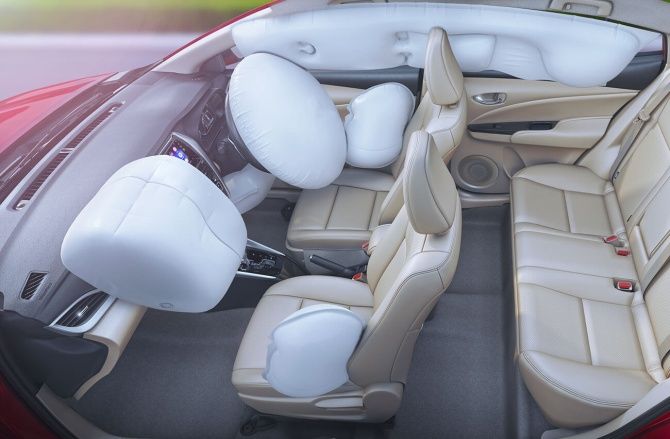Toyota is committed to safety, and its airbags are designed to provide the highest level of protection for occupants in the event of a collision. Toyota airbags are regularly tested and evaluated to ensure that they meet or exceed all safety standards.
Toyota also offers a variety of airbag safety features, such as dual-stage airbags, front-passenger-sensing airbags, and side-curtain airbags. These features are designed to provide additional protection for occupants in a variety of collision scenarios.
Toyota is constantly working to improve its airbag technology. In the future, Toyota airbags are expected to be even more sophisticated and effective. For example, Toyota is developing airbags that are tailored to the specific needs of individual occupants.
Aside from an airbag, a Supplemental Restraint System may also include seat belt pretensioners, an airbag clock spring, and roof-mounted curtain airbags. Faults can include sensor failures, an airbag control module, and problems with your seatbelt pretensioner. So if you think you might have a problem, it's best to leave the repairs to a professional.
Call Us: (571) 417-5717Toyota airbags are safety devices that are designed to protect occupants in the event of a collision. They are located in different areas of the vehicle, depending on the model and year. The most common locations for airbags are in the steering wheel, dashboard, front seats, and side doors.
Toyota SRS airbags are an important safety feature in Toyota vehicles. They can help to reduce the risk of injury or death in the event of a collision. If you are involved in a collision, your Toyota SRS airbags are designed to protect you and your passengers.
Toyota is committed to safety, and its airbags are designed to provide the highest level of protection for occupants in the event of a collision. Toyota airbags are regularly tested and evaluated to ensure that they meet or exceed all safety standards.

In the event of a collision, sensors in the vehicle detect the impact and send a signal to the airbag control unit. The control unit then triggers the airbags to inflate. The airbags inflate within milliseconds of the impact, providing a cushion of protection for occupants.
Benefits of Toyota SRS airbags - Toyota SRS airbags can help to reduce the risk of injury or death in the event of a collision. They can also help to cushion the impact of a collision, reducing the forces experienced by occupants. Additionally, Toyota SRS airbags can help to spread the forces of a collision over a larger area, reducing the risk of localized injuries.
There are a variety of different types of Toyota SRS airbags, including:
Driver airbags- These airbags are located in the steering wheel and are designed to protect the driver in the event of a frontal collision.
Passenger airbags- These airbags are located in the dashboard and are designed to protect the front passenger in the event of a frontal collision.
Side airbags- These airbags are located in the seats and are designed to protect occupants from side impacts.
Curtain airbags- These airbags are located in the roof and are designed to protect occupants from rollovers.
Knee airbags- These airbags are located in the dashboard and are designed to protect the driver's knees from impact in the event of a frontal collision.
Rear seat airbags- These airbags are located in the rear seats and are designed to protect rear passengers from side impacts.
Toyota SRS airbags are designed to last for the life of the vehicle, but there are a few things you can do to help maintain them:
Keep your vehicle clean: Dirt and debris can build up on the airbag sensors and interfere with their operation. Be sure to clean your vehicle regularly, both inside and out.
Have your vehicle inspected regularly: Take your vehicle to a Toyota dealer for regular inspections. The dealer will inspect the airbags and other safety features to ensure they are in good working order.
Replace the airbags if they are deployed: If your Toyota SRS airbags are deployed in a collision, they must be replaced. Do not attempt to reuse a deployed airbag.
Always wear your seatbelt. Seatbelts are the most important safety feature in your car, and they work best when used in conjunction with airbags.
Make sure that all occupants of your vehicle are properly restrained. Children should be in child safety seats or booster seats, depending on their age and size.
Keep your vehicle clean and well-maintained. This includes having the airbags inspected regularly by a qualified mechanic.
Be aware of the risks of driving. Always drive defensively and be prepared for the unexpected.
The dealer will start by disconnecting the battery. This is necessary to prevent accidental airbag deployment during the replacement process.
The dealer will then remove the airbag from the vehicle. This may involve removing the steering wheel, dashboard, or other components.
Once the airbag has been removed, the dealer will inspect the airbag inflator and other components for damage. If any damage is found, the dealer will replace the affected components.
The dealer will then install the new airbag and reconnect the battery. Finally, the dealer will test the airbag system to ensure that it is working properly.